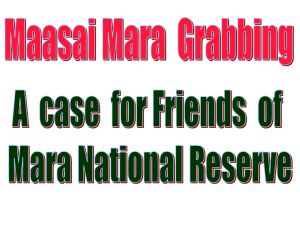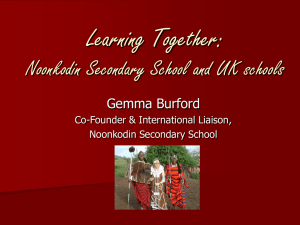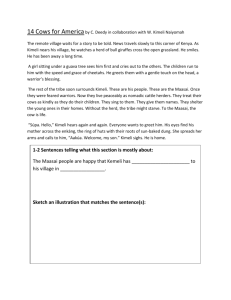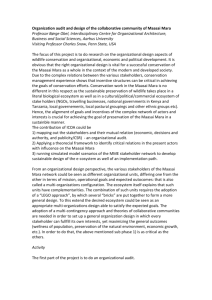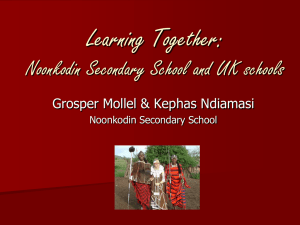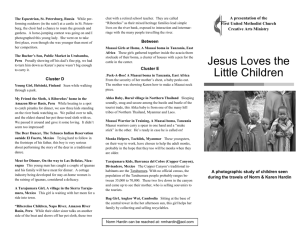In January, 2012, five Yelm women traveled to Kenya and spent six
advertisement
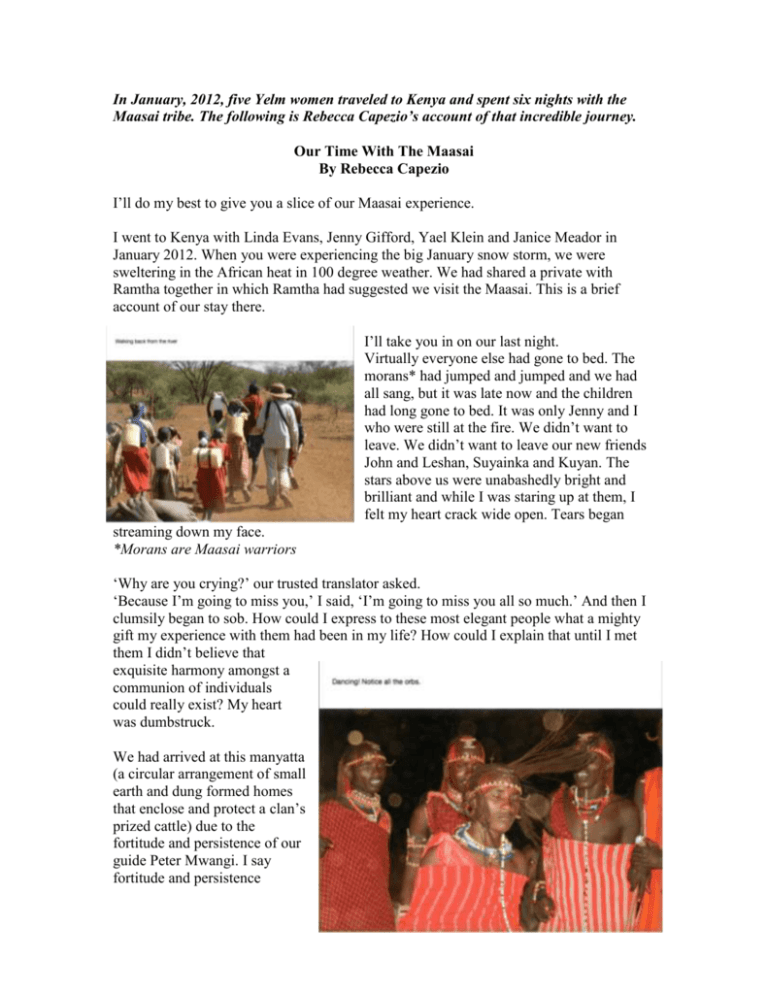
In January, 2012, five Yelm women traveled to Kenya and spent six nights with the Maasai tribe. The following is Rebecca Capezio’s account of that incredible journey. Our Time With The Maasai By Rebecca Capezio I’ll do my best to give you a slice of our Maasai experience. I went to Kenya with Linda Evans, Jenny Gifford, Yael Klein and Janice Meador in January 2012. When you were experiencing the big January snow storm, we were sweltering in the African heat in 100 degree weather. We had shared a private with Ramtha together in which Ramtha had suggested we visit the Maasai. This is a brief account of our stay there. I’ll take you in on our last night. Virtually everyone else had gone to bed. The morans* had jumped and jumped and we had all sang, but it was late now and the children had long gone to bed. It was only Jenny and I who were still at the fire. We didn’t want to leave. We didn’t want to leave our new friends John and Leshan, Suyainka and Kuyan. The stars above us were unabashedly bright and brilliant and while I was staring up at them, I felt my heart crack wide open. Tears began streaming down my face. *Morans are Maasai warriors ‘Why are you crying?’ our trusted translator asked. ‘Because I’m going to miss you,’ I said, ‘I’m going to miss you all so much.’ And then I clumsily began to sob. How could I express to these most elegant people what a mighty gift my experience with them had been in my life? How could I explain that until I met them I didn’t believe that exquisite harmony amongst a communion of individuals could really exist? My heart was dumbstruck. We had arrived at this manyatta (a circular arrangement of small earth and dung formed homes that enclose and protect a clan’s prized cattle) due to the fortitude and persistence of our guide Peter Mwangi. I say fortitude and persistence because this clan - headed up by their regal and engaging 96-year-old patriarch, was reticent to have us. Be assured this was no tourist trap! In fact, until the day we left, there were several toddlers who yelped with fright every time they saw us. But thanks to the glorious African tradition of listening to every voice until it is heard, eventually, after countless hours of to-ing and fro-ing over the course of 5 visits, Peter convinced them to let us come. What Peter hadn’t told us was nobody expected us to stay! Little did they know that our group was not easily daunted by the absence of running water, electricity and even a porta-potty. Being blindfolded at RSE for days on end had taught us something! So we set up our sleeping bags beneath our mosquito tents below that inky backdrop of forever (some of us more successfully than others) and we thanked the stars that had brought us here. The Maasai are famous in Kenya because in spite of their country’s march towards modernization, the Maasai have artfully preserved the culture of their ancients. In Ramtha’s ‘A Master’s Reflection of Humanity Part 2’ Ramtha explains just how ancient the lineage of the Maasai people is, and with the kind permission of RSE I have quoted the relevant section below. In that which is termed the latter days to that which is termed, as it were indeed, its destruction there came forth, as it were indeed, up into that which is termed the Mongolian lands, into that which is termed the Sudan, into that which is termed, as it were indeed, Egypt now in your counting, a great peoples, the composite made up of that which is termed northerners — or later to be called Ionians — and that which is termed, as it were indeed, Mu and Atlatian people. They came forth, as it were indeed, into the tribespeople that were all mahogany. The original Egyptians, as it were indeed, entity, were grand in their stature and reach in which is called seven feet in your term, as it were indeed, with mahogany skin and green eyes. They possessed, as it were indeed, into their gender that which is termed the copper-haired beauties with mahogany skin. When you are as old as I am, you see a lot of things happen in 35,000 years. The Egyptians are closest to the most royal dynasty that ever lived. They are closest to the Gods than the Israelites ever will be, because the Israelites are the ones who upseated that which is termed the original Egyptian kingdom. The Egyptians, their original blood, were the Watusi of Africa. The Watusi are the original Egyptians. They had red hair and green eyes — red hair and green eyes. The Gods of 455,000 years ago landed and helped to create their culture. Egyptians don’t look like all the rest of the Mediterranean people. How many of you know what the Watusi are, that wear the royal red? They even wear the royal plaid of Scotland. Don’t you have a mind of your own? Then why don’t you explore and investigate and know? You know, the great Africans that are six feet and above are the original Egyptians. They, in turn, are the original Scots. Turn to your neighbor and tell them that. Who are, in Africa, what is the name of the tribe that herds cattle and are fearless lion-hunters and wear red? The Masai and the Watusi are the same tribe. The original Masai and Watusi were ebony-colored skin but copper hair and green eyes. Where did their delineation come from? From the Gods beyond the North Star. That is original Egypt. Egypt is Africa. You can identify a Maasai moran (warrior) anywhere because to this day the men still herd their cattle wearing their red tartan cloth. As a show of strength and courage during their intense initiations, the morans hunt lions. Suyianka was fabled amongst our clan because he had succeeded, with the throw of his single spear, in bringing down a lion. Through our trusty translators John and Leshan who preferred the Queen’s English with phrases like ‘Surely, it is good. I will do my level best for you’ we heard Suyianka’s story. To richly understand the nuances of Suyianka’s story, I’d like to first explain a little more about life at the manyatta. In Maasai culture, everyone, however young or old, plays a part and contributes to the whole. Whether it is the tiny child carrying her tiny canister of water from the river, or the wise old patriarch who, without fail, counted the heads of his cattle when they left to find grazing at dawn and again when they returned at dusk; everyone has a clearly delineated role to play. Everyone is valued. And not just for what they do. For example, our translators, who themselves were hugely respected for their education and their understanding of English would say to us with the utmost pride and without a scrap of jealousy ‘Suyianka, he is handsome, is he not?’ Or they would tell us ‘Kuyan, he is our funmaker.’ Everyone in Maasai land is upheld for the unique offering they bring to the whole. They are upheld and they are respected. For instance, when we walked out into wild with the fabled Suyianka, he would never walk out in front of our translator John because John was his elder brother. In fact, the older you get in Maasai culture, the more you are revered for your wisdom and experience. (You can only imagine the difficulty we had in explaining how in our society, normally old people are shut away). But to the Maasai, age promises the next set of valuable responsibilities to the whole. For the young boys their hearts are set of course on qualifying to become an esteemed moran. By the time they are ready to take on this exacting initiation in their early teens, their mentorship in the wild - to learn everything imaginable about the plants and animals – is well underway. Whether it was a remedy for Yael Klein’s tick bite or Janice Meador’s interest in tasting their equivalent of chewing gum, the morans knew where to find it and what to do. They made fire quicker than you can say lickety-split. And all the while, in whatever task they were engaged with, the Maasai softly sing. They sing to their cattle, they sing to God, they sing about everything. They are the fiercest men you will ever meet, and yet they are also the gentlest men you will ever met. How often have you seen male friends holding hands while they walk? How often do you see a man, unasked, gently rearrange the folds of his friend’s cloth? Well, these men cared for each other as if they were limbs of the same body. And as virile and beautiful as they were and are, these young men never looked at us sexually. On yet another occasion when tears were streaming down my face at the marvel of it all, Leshan quietly got up and came and sat next to me. He didn’t say a word to me. He didn’t touch me. He simply upheld my heart. I actually don’t have words to describe the healing that went on in all of our hearts. To pass the test become a moran, the young teens have to endure a brutal, basic circumcision that is most often performed with a single razor blade. On no account is the initiate permitted to flinch. If he does flinch he fails the test, it is that simple. That is why the young teens are often seen tattooing their own flesh. They are expanding their pain threshold in preparation for their greatest test. When the young teens pass this mighty rite of passage to manhood, they braid their hair and adorn them themselves in the beadwork crafted for them by their mothers and admirers. The Maasai place great stock in the beautification of their bodies and they often have small mirrors attached to their clothing with which to admire themselves. We often chuckled because we would find grown men hanging onto the side mirrors of our land rover, idolizing themselves. The Maasai embody an extraordinary confluence between the feminine and masculine. They endure staunch camps out in the wild for months on end, yet they always return to their mothers’ houses. Their bonds with their mothers are thick because for the first 6 months of their lives, neither they nor their mothers are permitted to leave the pitch-dark interior of their small homes. For the first 2 -3 months of this sequestered period, their mothers are not allowed to lift a hand for themselves. They are waited on hand and foot. Visitors are permitted but on no account may the mother and child leave the dark womb of their interiors. After that, the mothers are permitted to tend to their own housework, but on no account are they permitted to see the light of day. Can you imagine how steeped in love and secure you would feel if that had been your introduction to this hurly-burly world? The greatest prize in Maasai culture is children and cattle. It is taboo in this culture to kill wild animals for food, so the milk and meat from their cattle and goats are literally their lifeblood. Accordingly these animals are cherished and revered. We were privileged to have a white cow slaughtered in our honor. When Grace (the name Linda Evans gave our cow) was led away from the rest of the herd she seemed to know what fate had befallen her, and remarkably she appeared to willingly surrender to it. We were all nervous about witnessing Grace’s slaughter, particularly since Ramtha had challenged us to drink her blood like the Maasai do, so we braced ourselves for this event. Once Grace had been pulled to her knees on a bed of branches, we observed some of the morans moving away from us. ‘Why are they leaving?’ we asked our translators. ‘Because they love her too much to witness to first blow to the back of her head.’ We held our breath. What happened then was sheer poetry. Within an hour, Grace’s skin was lying out to dry in the sun and every muscle and sinew of her body had been apportioned out to the different tiers within the clan. Even the dogs were given specific portions of her meat, and we certainly feasted on Grace for the remainder of our time there. And yes, led by the courageous Yael Klein, we all bent down over Grace’s fallen body and sipped the warm, nourishing outflow of her blood. We had passed the test! On another occasion, two bulls were fighting within the enclosure of the manyatta. The morans had been observing their war for dominance for some time, and because they didn’t want the young children to witness this warring behavior and perhaps learn from it (truthfully, that was the reason they gave us) the morans decided to let the bulls have it out. There was a sudden skirmish within the enclosure as the bulls were commandeered out of the encampment and within a minute, in clouds of red dust beneath Kilimanjaro and the setting sun, the dominant bull asserted his right to head the herd. Then quietly, peacefully, the bulls were returned to their enclosure and peace was restored for the night. There is so much more I could tell you about our time with the Maasai, but in the interests of not writing a book, I’d like to return to the beautiful Suyianka and his lion hunt. It is intriguing to learn that the lions in this area, genetically over generations, are now encoded to fear the morans. As long as they are wearing their red, 10-year-old boys can head off unprotected into the wilderness to tend to their cattle, because no lion would dare take on the Maasai! When the hunt is on, and a lion is skillfully tracked down, the morans call in their fellow hunters with a particular whistle and then they arc around the lion and begin to entrance themselves with song. ‘Why do you sing?’ we asked. ‘We sing for courage’ they told us. It is important to understand that each moran only carries one spear, and whoever throws the first spear becomes the avenging lion’s target. So if you fail to bring down the lion with your one and only strike, you then stand unprotected against the fearsome charge of the lion headed directly towards you! No wonder courage is sung for. ‘Then I called out the names of my ancestors’ Suyianka told us. ‘And then what happened?’ we asked with bated breath. ‘I don’t know’ Suyianka said. ‘The next thing I knew I was standing over the lion’s body and the lion was dead.’ So there I was on our last night, staring into the fire with Jenny, Suyianka, Kuyan, and Leshan, and I was willing myself not to sob out loud. ‘Don’t cry’ Kuyan the funmaker told me, ‘Don’t cry, Rebecca. God brought us together and God will not keep us apart. We are one, don’t you know? We will follow you with our blessings all the way home in your airplanes. We are one with you, don’t you know?’ One day, hopefully in the not too distant future, I will return to my other family with my own children. Until then, no doubt like my sisters Jenny, Janice, Linda and Yael, I will never forget Kuyan’s wisdom. I will always, always remember that in God we are all one. I’m happy to tell you that between our group we are funding the university education of our two translators, the high school education of one of the clan’s sons, and we are also doing our ‘level best’ to get a well drilled into that parched, red earth. It is the least we can do.
